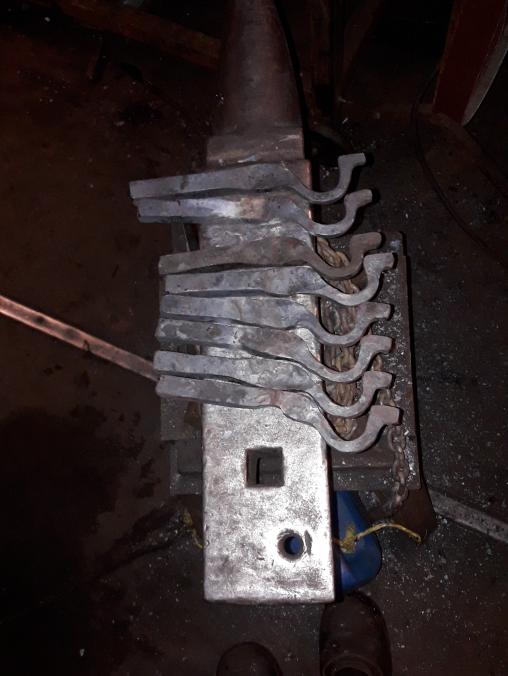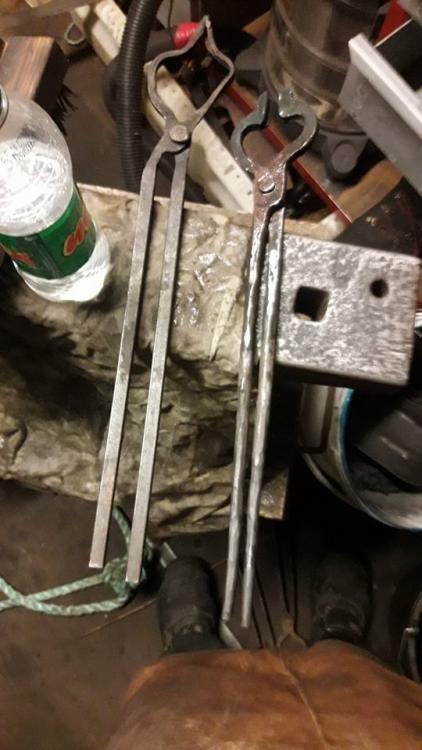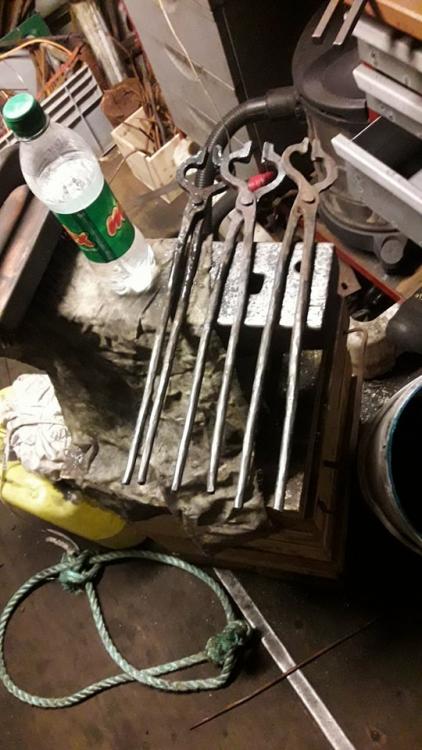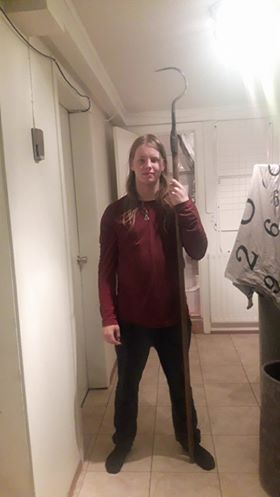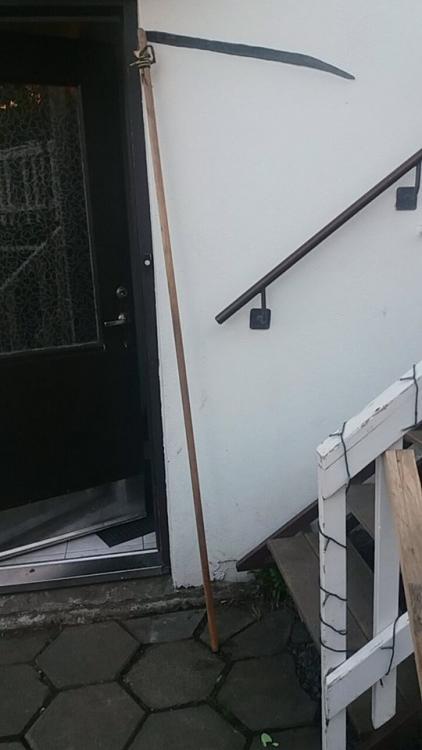-
Posts
268 -
Joined
-
Last visited
Content Type
Profiles
Forums
Articles
Gallery
Downloads
Events
Everything posted by Dabbsterinn
-
that would be a fun one but I'm still struggling with just getting a billet welded together, maybe I'll practice pattern welding more, I'll make it my 10 year milestone
-
So a memory just popped up on my facebook feed showing my first complete project, I figured I should celebrate my 5 year milestone so are there any suggestions on what I should make or do in the shop?
-
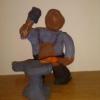
What did you do in the shop today?
Dabbsterinn replied to Mark Ling's topic in Blacksmithing, General Discussion
finished 3 out of 4 tongs that I've been working on for the past few days, I would have finished the fourth one too but I broke the rivet when I was trying to get the reins to move just a little bit so that I could have a better grip on them once I heated them up again. I would have just driven the rivet out but I used the last piece of 8mm round to make that rivet and I didn't feel like scrounging through the small stuff pile in hope of finding something close enough so I just called it a day there. I made them all at the same time, in the beginning I just took one heat on each blank and before I pulled the hot one out of the fire I put the next one in and so forth, that made for a really nice pace with enough time between heats to take a sip of water and give myself a short little rest I also compared my first bolt jaw tongs to my latest, all in all I've finished 6 bolt jaw tongs to this day -

Little things that make a BIG difference
Dabbsterinn replied to C-1ToolSteel's topic in Shop Tips n' Tricks
standing properly at the anvil, I learned that one just today. before I was just standing at the anvil like you'd normally stand, feet side by side about a shoulder width apart and bending at the knees but finally my friend pointed out that I should try moving my right foot (I'm right handed so it most likely goes opposite for you lefties) a bit back and to the right, something akin to most martial art basic stances and stand 30-45 degrees to the anvil. I felt how it engages the Latissimus dorsi (the muscle just under your arm) in my side a lot better, therefore relieving the bicep and triceps of some strain, it also brought me down just enough so the anvil was at a perfect height for working with smaller diameter stuff and I personally find it easier to lift myself up on my toes a little bit to get that slight extra swing and power which makes the work a little bit easier for me and in turn makes a big difference at the end of the day for me at least -
they're actually not tight, also all of the layers are rather thin, they go something like this: wool undershirt> long sleeved shirt>flannel shirt>fire retardant shirt>sweater they're all loose except the undershirt and in my experience I don't sweat unless the forge is running on full power and I'm striking but then I just take the sweater off and I'm good. I have a feeling that the reason I'm not sweating is because my feet are always cold-ish, not enough to bother me but I'll give this technique a try next time it gets that cold here thank you for the advice Mr. SLAG
-
I'm subscribed to 131 youtube channels, that's usually how I handle cabin fever, that or I put on 5 layers of clothes and just deal with the cold when it hits -14C (6F)
-
Ever since I moved and joined my friend in his smithy, I've found that I really enjoy striking and in the process learned a different way to strike than what I had always done, the one I learned first I believe is called the european method, that's atleast the word I saw in one article I read ages ago where you hold the sledge with your strong hand nearer the head and the opposite foot infront of the other, not far from most martial art basic stances. The method I picked up from my friend has me standing straight with a shoulders width between my legs and standing up on my toes as I bring the sledgehammer up and slide the hand down the shaft on the downswing, a good example of that technique is most of Alec Steele's videos where he's striking. The difference that I notice between those two techniques is mostly the force generated, the sledgehammer travels further and I feel like can bring it down with more speed with the latter technique however I find it less accurate and more time passes between blows so most of the time I use this "european technique" since we almost always are using top tools and I'm both more experienced with that technique and I feel more accurate. Now to the point of this post, regardless of technique used after 4-5 heats my arms are practically exhausted so I believe I might be doing something wrong (a video is coming shortly of me striking with both techniques) but does anyone have any tips on how to strike longer and maybe even better? are there any techniques that I don't know about that might be useful? also the sledgehammer I'm using is 16 lbs I believe for fun, lets also see your sledgehammers and if you have any fun stories regarding striking I'd love to hear them
-

unknown anvil, help is appreciated
Dabbsterinn replied to Dabbsterinn's topic in Anvils, Swage Blocks, and Mandrels
I just stumbled upon this topic while browsing through my old content and as far as I can recall that's a Skoda anvil, I saw another one for sale on facebook not so long ago with a more crisp logo and that's without a doubt the skoda logo, just in case anyone should find their way to this thread at some point in the future and would want to know the answer -
here's a nice little habit I'm trying to get myself into that I believe will be nothing but beneficial, I aim to always carry a notebook, or just a small notepad on me and a pencil to sketch out or write down ideas, I know there are a lot of ideas that are amazing that I've forgotten simply because I didn't write them down, have a designated pocket for it and the moment you get an idea, write it or sketch it, I think keeping it in as few words as possible might make it either easier to remember or improve on since you wouldn't be constricting yourself to a certain idea, unless that's what you'd want. Also another good use for a notebook is writing down goals and when you want to have them accomplished, I learned that one from a speech I heard some years ago, I think the coach for the Icelandic handball team uses this and in 2005 or something he simply drew a medal and wrote 2008 on it, that year during the olympic games we won silver so I believe it works
-

teaching my friend the basics and a bit more
Dabbsterinn replied to Dabbsterinn's topic in Blacksmithing, General Discussion
after some thinking and feedback, I think splitting this over 2 weekends or more would be a good idea -

teaching my friend the basics and a bit more
Dabbsterinn replied to Dabbsterinn's topic in Blacksmithing, General Discussion
Fixed, can't believe I forgot that in the list -
So at some point in the future, most likely soon, a friend of mine is getting himself a nice little forge and I thought I'd teach him a thing or two (actually 20 so far) and I thought I'd actually plan a little bit ahead for once and write down a list of the things I'll walk him through in order and I think sharing that list here might be a good idea so that others might either use it or help me add to it or modify it Safety will be lesson 0, proper PPE, hearing protectors, gloves when appropriate, when gloves are appropriate, for example when punching or chiseling, and safety glasses at all times fire management, since we'll be using coke first we'll most likely sit down and have a chat about fire management, how to do it and why it's very important to manage the fire, he'll of course need a coal rake, I'll use that project to get him warmed up and give him a quick introduction into tapering, flattening and making an eye round to square and back again, maybe I'll incorporate that into the rake itself make a punch, punches are one of the most useful tools in my opinion and are relatively easy to make, this is also a good point to discuss the metallurgy of steel, why we need this steel for that and not for this and so forth how to punch, doesn't make much sense to teach him how to make a punch but not how to use it chisel. another simple project that leaves you with a really useful tool twisting. I might incorporate that with the chisel, rake or something else drawing out. I'm leaving that as a specific lesson since I'll be teaching him to draw out over the edge of the anvil, the punch, chisel and rake are mostly done on the face of the anvil since the materials we'll be using are already pretty close to the final dimensions flattening. if he'll be having the same issues that I've been having with that drawing out technique, he'll have not exactly a flat finish, so next part would of course be teaching him to make it flat using the face of the hammer bending, that one describes itself, doesn't it? I'll show him how to use the edge, the horn and a bending fork to do this, main focus will be on 90 degree bends, eyes and such scrolls will just be a continuation of the last lesson, both on the anvil and with scrolling tongs now to finally make something cute and give him a small break from the tool making and practices, a nice little J hook for him to hang his apron on or something, of course incorporating all the previous steps such as punching, twisting, tapering, flattening and all that upsetting, depending on how well the J hook goes, he already might be a bit upset but once he has a nice J hook, I'll teach him the other meaning of upset, both by dropping the stock on the anvil and hitting the end of the bar on the anvil forge welding? I'm not entirely sure about that one, It's still not a very easy task for me but I know I can do it with a fair amount of certainty rivet and nail header, If my friend is anything like me he'll want more tongs sooner than later, so I'll start off by teaching him how to make a rivet and nail header, he also has a use for nails and IMO they're a great warm up project how to make nails (read above) how to make rivets (read above) Lady knife, not entirely sure if there's another word for them but that's just a translation of what we call them in Iceland, I'm pretty sure the other nordic countries have a similar name for it, the handle is just a long taper that's bent back usually with a small scroll on the end Mjölnir pendant, we're both in the Viking re-enactment group and we're really fond of jewelry so that's a given project bolt jaw tongs, by the time we've reached this lesson he should hopefull have enough hammer control and an understanding of the craft to be able to make bolt jaw tongs with my guidance I'm estimating that this should be about one weekends worth of work, starting after lunch and quitting sometime just before 10 or so in the evening, but that's a very rough estimate
-

What did you do in the shop today?
Dabbsterinn replied to Mark Ling's topic in Blacksmithing, General Discussion
made my prettiest tongs yet from a coil spring, my friend and I are thinking about finally making that rounding hammer later today that I was promised nearly a year ago, after I weld some high carbon steel for my hot cut and make a handled hot cut -
technically I ended up following him home, but I met this guy 5 years ago at a blacksmith demonstration, he told me that he was also a blacksmit and I recalled seeing his posts in one of the facebook groups I'm in, we started talking a bit, he asked if he could forge something, I gladly allowed him and now, 5 years later we're the best of friends and renting an apartment together and we got a lovely little smithy set up in a shipping container, those who remember my first posts here might start thinking that I have a thing for shipping container smithies IIRC he's also a member here @kobbsky
-

What did you do in the shop today?
Dabbsterinn replied to Mark Ling's topic in Blacksmithing, General Discussion
I made this gaff hook, I often fish in the harbor and I've lost a handful of nice fish just because my old gaff hook was a little bit too short and that was on high tide, with this I can safely bring them in even during low tide (I'm 5'7/1,73 for comparison), another fun fact, I had promised myself to be home by 12 in the evening when I started this but my friend showed up to the smithy one thing led to another and I finished driving the pin through the handle sometime around 5 in the morning, safe to say I had a good long sleep after that day -

What did you do in the shop today?
Dabbsterinn replied to Mark Ling's topic in Blacksmithing, General Discussion
finished the scythe I've been working on, just gotta finish the snath and give it a go in the yard, I'm kinda worried that I didn't curve it enough but worst case scenario it's a wall hanger and a lesson in drawing out since I started with 20mm round bar -
I imagine a few of us here have some high grit stones for sharpening and polishing and with me being the DIY nut that I am, I've been wondering if I could make my own honing stones, I have used basalt rocks that I just picked up off the ground, dipped in water and got a decent edge with it after using my synthetic no name stone. So naturally I started thinking about how I could improve this but I'm no rock expert, atleast not the mineral type but I know about some rock types found in Iceland, like Jasper, Basalt, some kind of sandstone, what I believe is Catlinite, Dolerite, quartz and Gabbro, has anyone here made or heard of these stones being useful for sharpening? I'm trying to find some very high grit stones so if anyone can tell me how I can tell if it's high grit or not and how I should go about turning the stone into a nice flat whetstone I'd be very grateful
-
when you're walking with hot stock, hold it like you'd hold a knife while walking, down by your side. had a visitor in the smithy, my flatmates girlfriend and I realized that I often forget to mention that part when I saw yellow steel and felt the heat fly not much more than an inch from my face when she was going to the anvil, If you can't hold it like that, yell something like "hot steel coming through" loud and clear Other safety advices that I find very useful: If you're not sure if something is hot, SLOWLY pass the back your hand or fingers over it, the skin is thinner there and if you do get burnt, it's atleast not in the inside if your hand. If you're not sure, ask, even if it sounds dumb, it's always better to seem dumb for a few seconds rather than being dumb for the rest of your life, injured or worse (for the internet though, it often helps to do some research first, since you're already on the internet) Use the right tool for the job, just a few hours ago I stopped my flatmate from most likely ruining a perfectly fine flathead screwdriver and told him to make a punch instead, thankfully he went on a little bit of a tool making/fixing spree and now we have a ball punch, slot punch, 2 refinished punches and a new edge on my cut off which my flatmate managed to dent within an hour after filing it SAFETY GLASSES, there's a saying in Iceland, a good song is never too often sung, but this is a sllightly different song, I've been getting lazy with the glasses but today I got a very stern reminder, I used some charcoal to help the coke along and I was gathering my tools and getting ready to start forging, I hadn't put my glasses on yet since I wasn't doing any work that could throw stuff into my eye, or so I thought, I looked at the fire to see how it was going and then I heard that familiar sound when wood pops when it's burning then a tiny piece of burning coke nailed me right in the eyelid, thankfully I flinched and blinked, now I have a tiny blister on the edge of my eyelid, it's literally less than 0.4 MM from my eyeball, (1/64 of an inch for those who understand that better than metric) from now on the first thing I'll do when step into the smithy is put on a pair of glasses if I don't already have them on If you're working with other people in the smithy, make sure you know where they when you'll be taking anything hot out of the forge or carrying heavy stuff, you don't want to suddenly bump into your friend while holding an anvil or hot stock, it's also a good practice if youre working alone to quickly glance at the anvil or the path you'll be walking before bringing the piece out of the fire or picking up the heavy thing both to get used to doing it and making sure there are no obstacles or just to make sure the hammer is where you put it down. Make sure the tongs you're using fit the piece you want them to hold, I hope I don't need to explain that one, flying steel isn't fun, especially if it's hot, unless you're on the shooting range or hunting When you brush the scale off, make sure you're brushing it in a safe direction, safe being something that won't catch on fire like the newspaper that I was too lazy to pick up that's about all the safety tips that I can think of that I didnt' see/forgot that I saw in this thread. a
-

Flintlock project
Dabbsterinn replied to Dabbsterinn's topic in Gunsmithing, Muskets, Flintlocks etc
Of course you may suggest, kind sir, I'll bookmark these sites and browse them when I'm not procrastinating on studying for my finals, those books might come in handy when I make a rifled version, first one will most likely be a smoothbore -

Flintlock project
Dabbsterinn replied to Dabbsterinn's topic in Gunsmithing, Muskets, Flintlocks etc
Excellent idea Thomas regarding the intermediate step, I'm hoping to have a gun that I feel safe shooting in 1 1/2-2 years but if it takes 10 I'll take 10, I'll even bring the vice and all that with me to the retirement home if that's what it takes. Thank you Dan for the welcome, I'm currently trying to get a hold of my friend to order those books, unfortunately I get a 403 error on the second link, I have a feeling that this website is gonna hurt my wallet big time but that's way better than myself or my friend getting severely injured, I figure we'll order a cheap flintlock just to get a proper feel for it and be able to inspect it carefully from all angles -

Flintlock project
Dabbsterinn replied to Dabbsterinn's topic in Gunsmithing, Muskets, Flintlocks etc
Thanks a lot for the link, I'm not sure why I didn't think of looking for a forum first. I'd love to if I had any trips planned to the states, about the will though, even if I put you in there you're most likely going to have to wrestle my anvil out my friends hands, he's been drooling over my söderfors ever since we first met -
I don´t remember exactly when I got my interest for flintlock rifles but my friend and I are determined on making at least two as soon as we trust our skills well enough and have the licence to make them but it´s gonna be at least a year until that happens so I´m going to use that time to study and research everything I can get my hands on and I figured this might be the right place to both record this research and share the information with all of you, maybe even get some helpful input. I think I have the rough idea on how to do it now but since I quite like my head I´m not all that interested in having the breech fail on me and go backwards, I´m going to need way more than that rough idea. The plan so far for this gun is quite elaborate so it´s going to need safety precautions that will make OSHA proud, I´m planning on making a pattern welded barrel like the ones made in Nessonvaux, for that I´ll need tough steel that´s not too hard to forgeweld and can give off a good pattern, my current ideas are 4140 and L-6, I´ll order the stock of course but I´m not familiar with the weldability or how the pattern develops on those two. Just in order to make the barrel I imagine I´m going to have to make a swage block and top swages, a mandrel for forgewelding it on, a large twisting mechanism for even twists and something to aid with coiling the barrel around the mandrel and a gauge for getting the correct thickness. I'll see if I can get the barrels X-rayed somewhere just to be safe and I'll mount it to a plate somewhere far from civilization and try shooting 4 times the recommended amount of powder (charge? load? ) after that I'll take it to a professional gunsmith and get him to inspect it. I think I understand how the trigger mechanism works, I'll probably make that out of some new car leaf springs, atleast the springs and the frizzen. I believe common mild steel is fine for the tumbler, trigger, pan and all that, I also want to try to use mokume gane for all brass parts like trigger guard, the things that hold the ram rod because I like having pretty stuff. now that I think I have the plan so far laid out I have a few questions, how should the breech plug be attached, I'm considering forgewelding it first and then just give it a precautionary TIG weld where the seam should be, what kind of files would I need for this since I understand that 80% of a gunsmiths work is filing or would it be OK to turn it on a long lathe and how would you forgeweld the barrel together, I'm mostly looking for alternatives to the method they used in Nessonvaux and just general tips or tricks you might have for me https://www.youtube.com/watch?v=fa9dlvRDuQU here's the Nessonvaux video if you haven't seen it before https://www.youtube.com/watch?v=bAzJOULyx5c&t=3124s Here's Wallace Gusler making a rifle, I'll be watching this one over and over and taking notes, if you have more videos or pictures of people making guns I'd be very grateful if you would share them here
-
Recently I stumbled upon a youtube channel with loads of amazing glass blowing videos and I've probably spent a few hours glued to my screen drooling over the videos, so I of course started thinking about doing this myself, has anyone used a propane forge with Frosty's T burners for glass blowing? are there any reasons why that wouldn't work?, my biggest concern is it might be too hot
- 5 replies
-
- glass blowing
- glass
-
(and 1 more)
Tagged with:
-
I'm awfully glad i found this thread before I sanded my laburnum axe handle, is a high quality respirator good enough or would I need something more than that?
-
I've used calipers instead of tweezers with good success, if it's really stuck in there i sometimes go in with a needle and scrape up the first layer of skin around the splinter then its easier for me to get a hold of it

